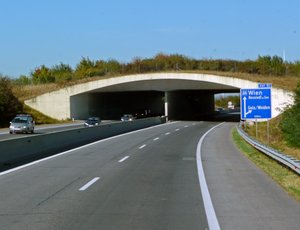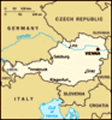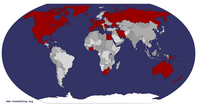Advertisement
Published: March 13th 2024

 Autobahn A4 Underpass
Autobahn A4 Underpass
Autobahn A4 underpass near Gols, Austria. En route from Budapest to Vienna.
P1260037p1We left Budapest at 8:00 a.m. for Vienna. The coach followed the M1 motorway through Hungary and then picked up the A4 in Austria. The drive took us through the Little Hungarian Plain, an area of rolling countryside south of the Danube in Western Hungary. After a rest stop midway, we reached Vienna at about 11:20 a.m. There was a break or lunch on our own before meeting for a walking tour of central Vienna. Susan and I stopped at Rosenberger, a cafeteria-style restaurant with a salad bar, hot food bar, and prepared foods for takeaway.
Our drive connected the two imperial capitals of old Austria-Hungary. So, it seemed appropriate that our first stop in touring Vienna was the Hofburg, the Habsburg palace in the center of the city. We did not visit the state apartments inside the Hofburg but walked around the perimeter. The palace grew over time, resulting in a sprawling complex. The more well-known parts are from the 18th and 19th centuries. The group left the coach behind and began our walking tour at the Josefplatz. In the center stands an equestrian statue of Joseph II (1741-1790). He was Marie Antionette's brother and a patron of Mozart

 Hofburg: Michaelertrakt
Hofburg: Michaelertrakt
A Viennese Fiaker (two-horse carriage) passes the Michaelertrakt pavilion of the Hofburg.
"The Chief Façade in the Michaeler-Platz, erected in 1889-93 by Ferd. Kirschner, from an old engraving, completes for the outside of the Reichskanzlei the design of Fischer for its inner façade. This outer façade, flanked with two domed pavilions, recedes slightly towards the centre, where a massive portal, crowned with a lofty dome, forms the entrance to the palace-yard."-Baedeker 1911
P1260077and Salieri. At the head of the square is the Austrian State Library, the former Court Library, Austria's national Library. At the right is the Redoutensaal, an imperial assembly hall and ballroom, now a venue for conferences and events. Behind the square runs the Reitschulgasse, disappearing into an arcade through the Redoutensaal. (This is the location of a scene in the film
The Third Man.) Following the Reitschulgasse, we came to the famous Spanish Riding School. At right was the 17th-century Stallburg, the stables for the Lipizzan horses. At left is the 18th-century Winter Riding School building, home of the Spanish Riding School and its shows. The Reitschulgasse empties into Michaelerplatz, the front and main entrance to the Hofburg. The Michaelertrakt (St. Michael's Wing) was initiated in the 18th century but was not fully built until 1889-1893. The green-domed Michaelertor is the gateway to the inner courtyard of the palace.
Quitting the Hofburg, our guide led us from Michaelerplatz along the pedestrians-only Kohrnmarkt to the Graben. The downtown area from the Hofburg to Stephansdom forms the core of the Historic Centre of Vienna UNESCO World Heritage Site. Kohrnmarkt is the beginning of the high-end downtown shopping district. Demel, the

 Hofburg: Michaelertrakt
Hofburg: Michaelertrakt
Hofburg: Michaelertrakt. The southern gateway to the Hofburg was completed in 1893.
"The Chief Façade in the Michaeler-Platz, erected in 1889-93 by Ferd. Kirschner, from an old engraving, completes for the outside of the Reichskanzlei the design of Fischer for its inner façade. This outer façade, flanked with two domed pavilions, recedes slightly towards the centre, where a massive portal, crowned with a lofty dome, forms the entrance to the palace-yard."--Baedeker 1911
P1260079famous Viennese cafe and chocolatier, is located here. The Graben is an elongated square marking the center of Vienna. There are more shops here and monuments such as the Pestsäule (Plague Column) of 1693 and the Leopoldsbrunnen. It was the bustling hub of the city. During my visit, I witnessed two fashion shows taking place in the middle of the Graben. One show featured a spokesmodel dressed as the Fashion Police, promoting the Grazia Style Finder Tour 2011, a search for the best street style. In another event, people were dressed up in black rubber outfits resembling tires or licorice ropes. I couldn't figure out what they were advertising. The Graben ends at Stock-im-Eisen Platz, connected to Stephansplatz. At Stephansplatz is Stephansdom (St. Stephen's Cathedral).
St. Stephen's Cathedral, also known as Stephansdom, is a significant symbol of Vienna. It is situated in the heart of the old city and has witnessed a pageant of historical events since the 12th century. The land on which the cathedral stands is believed to have had a cemetery dating back to Roman times before the first Romanesque church was built in 1137. The current cathedral church was constructed over the old one in

 Hofburg: Michaelertrakt
Hofburg: Michaelertrakt
Hofburg: Michaelertrakt. The southern gateway to the Hofburg was completed in 1893.
"The Chief Façade in the Michaeler-Platz, erected in 1889-93 by Ferd. Kirschner, from an old engraving, completes for the outside of the Reichskanzlei the design of Fischer for its inner façade. This outer façade, flanked with two domed pavilions, recedes slightly towards the centre, where a massive portal, crowned with a lofty dome, forms the entrance to the palace-yard."--Baedeker 1911
P12600861230. We were fortunate to enjoy a complete tour of the cathedral. The West façade and twin towers, the
Heidentürme, are Romanesque in style. In the early 14th century, the conversion of the Choir into Gothic form began, and this work continued until 1440-1454, resulting in the Gothic Nave's high vaults. The South Tower, the most notable feature of the cathedral, was added between 1359 and 1433. It rises to a height of 445 feet (136 m) and can be climbed by visitors. It was used as a watchtower until 1955. I should also mention the unique tiled roof, which comprises more than 250,000 glazed tiles.
The inside of the nave is long and rather dark, but there are many treasures to be discovered. The High Altar, which was built between 1641 and 1647, represents the stoning of St. Stephen. It is surrounded by figures of patron saints from the nearby areas, such as Saints Leopold, Florian, Sebastian, and Rochus. Close to the High Altar, there is the Wiener Neustädter Altar, consisting of two triptychs. This altar was originally commissioned for an abbey in 1447 and only arrived at St. Stephen's in 1885. The panels on the altar show

 Österreichische Nationalbibliothek
Österreichische Nationalbibliothek
Österreichische Nationalbibliothek - Austrian National Library. Josefsplatz main entrance. Built in 1735. Josefsplatz 1.
"The Imperial Library (Hofbibliothek), in the S.E. wing of the Hofburg, facing the Josephs-Platz, was erected by J. B. Fischer von Erlach, and completed in 1726. The domed central building is crowned with a Minerva in her quadriga, while the wings are presided over by Atlas and Gæa, with the celestial and the terrestrial globe respectively. ... The Library contains 1,000,000 vols. (incl. 8000 incunabula) , 33,000 MSS., 350,000 engravings, 50,000 pieces of music, and 30,000 autographs."--Baedeker 1911
P1260063gilded wooden figures depicting several saints and events in the life of Mary. In the Nave, an elaborately carved stone pulpit depicts St. Gregory the Great, St. Jerome, and St. Augustine of Hippo. On the right side of the High Altar is the Tomb of Frederick III (1415-1493), Holy Roman Emperor. This red and white marble tomb was completed in 1513. The Baptistry is located in St. Katherine's Chapel at the base of the South Tower. Mozart's sons Johannes and Franz were baptized here. (Wolfgang Mozart and Constanze Weber were married at St. Stephen's in 1782.)
From Stephansplatz, the tour guide took us on a walk for several blocks to reach the wide Franz-Josefs-Kai boulevard that runs alongside the Donaukanal. The coach parking area was located here, where our coach was waiting for us. We boarded the coach and drove around the Ring, heading for our next stop, Schönbrunn.
Schönbrunn Palace, or Schloss Schönbrunn, was an imperial home of the Habsburgs and is a UNESCO World Heritage Site that visitors to Vienna must see. Schönbrunn means "beautiful fountains." (There are two fountains in the forecourt and a large Neptune Fountain in the gardens.) The palace has 1,441 rooms

 Josefsplatz
Josefsplatz
Josefsplatz at the Hofburg with the Redoutdensaale in the background. "This historic hall served as the setting for many profoundly important historic events: Mozart operas, the debut performance of Beethoven’s 8th symphony, works by Franz Liszt and Josef Strauss." The Redoutdensaale is now a banquet and events venue.
"The Josephs-Platz, in which rises a bronze Statue of Joseph II (1780-90) on horseback, in Roman garb, by Fr. Zauner (1807), is bounded on the N.W. by the Redoutensäle of the Hofburg, on the S.W. by the Hofbibliothek ..."--Baedeker 1911
P1260064and was originally a 14th-century country estate. Emperor Maximilian II bought it in 1569 as a hunting lodge, but the original structures were destroyed during the Turkish siege of Vienna in 1683. A new chateau was built over the old foundations by 1700, forming the central core of today's palace. Empress Maria Theresa played an important role in expanding Schönbrunn. She added side wings and remodeled the central portion and interior in Rococo style between the 1740s and the 1770s. The palace that we see today is the result of her efforts. The "Schönbrunn Yellow" exterior color was applied in 1819. Visitors can explore the richly furnished rooms where Maria Theresa, Elizabeth of Austria (Sisi), and Franz Josef once resided and Mozart performed. When the last Habsburg Emperor, Karl, abdicated in 1918 in favor of the Austrian Republic, Schönbrunn and its contents became a national property. Unlike many European palaces, the sumptuous furnishings and decor are still intact as they were when the Habsburgs left. The palace's imposing rooms, such as the Great Gallery with its gold work, mirrors, and ceiling frescoes, are preserved through ongoing conservation work. (When we visited, Schönbrunn was receiving its first electrical upgrade since 1901.)

 Equestrian Statue of Joseph II
Equestrian Statue of Joseph II
Equestrian statue of Joseph II (1741-1790), Holy Roman Emperor, in Josefsplatz. Installed in 1806.
"The Josephs-Platz, in which rises a bronze Statue of Joseph II (1780-90) on horseback, in Roman garb, by Fr. Zauner (1807) ..."--Baedeker 1911
P1260071The palace also provides visitors with rich insights into the lives of its former inhabitants. Empress Sisi, in particular, is a popular figure, and her gym, where she liked to work out, is included in the interior tour, along with Franz Josef's apartments and the beautiful Sisi's apartments. Unfortunately, interior photography is not permitted. The Sisi Shop is the Schönbrunn gift shop. Everything Sisi-related can be found here, from Sisi Stars jewelry to a Sisi Pez dispenser!
There was time to tour some of the vast Gardens stretching behind Schönbrunn, but not enough time to experience all of them. Maria Theresa's landscape architects designed the layout of the Gardens, including the Great Parterre, Neptune Fountain, and Gloriette.
Late in the afternoon, we checked into our hotel, the Hotel de France on the Schottenring. After Susan and I unpacked and had a chance to relax, it was time to go again! We had booked the Heurigen Dinner optional excursion on our Globus Imperial Splendors tour. Thus, around 6:30 p.m., it was time to head for the Vienna suburb of Grinzing.
This was a most enjoyable outing! Susan and I indeed had a lovely evening at Heuriger Reinprecht in

 Spanish Riding School
Spanish Riding School
Hofburg: Spanish Riding School entrance.
P1260070Grinzing. A
Heurige is a Viennese wine tavern where the most recent year's vintage is sold, and cold and hot food is also available. Such an establishment is considered different from a restaurant. We were served a family-style dinner, with an appetizer of Liptauer cheese spread with Swiss cheese, ham, salami, and bologna arriving first. The main dishes each arrived on large serving platters. We could then make our own selections from Wiener Schnitzel, boiled beef, chicken, ham, Wurst, Geröstete Erdapfel (roasted potatoes), and sauerkraut. It was all delicious! I had some extra Wiener Schnitzel, so I had no room for dessert. Both house white and red wines rounded out the meal. It certainly was a bit of Viennese tradition to experience. There were some locals here, though most diners were visitors. Strolling musicians entertained with traditional
Schrammelmusik during dinner. A lot of fun! (I observed that the musicians could identify the Americans and sought tips, but not from the European guests present.) Heuriger Reinprecht has several claims to fame. It is located in a 300-year-old building, a former monastery. The operetta composer Robert Stolz was once a regular customer and composed music here. (There is a plaque honoring him.)

 Redoutensaal
Redoutensaal
Hofburg: Redoutensaal wing. Built in 1705 and redesigned and rebuilt under Maria Theresa in 1748.
"This historic hall served as the setting for many profoundly important historic events: Mozart operas, the debut performance of Beethoven’s 8th symphony, works by Franz Liszt and Josef Strauss." The Redoutdensaale is now a banquet and events venue.
P1260072The Heurige also displays the largest collection of wine bottle corkscrews!
Advertisement
Tot: 0.094s; Tpl: 0.015s; cc: 13; qc: 28; dbt: 0.0257s; 1; m:domysql w:travelblog (10.17.0.13); sld: 1;
; mem: 1.2mb




















